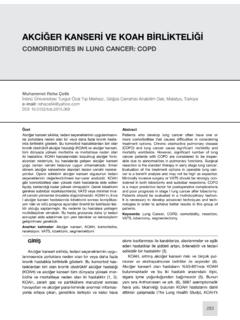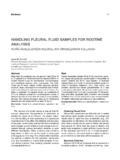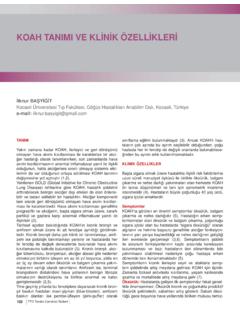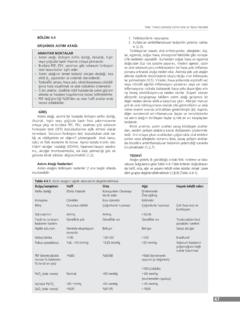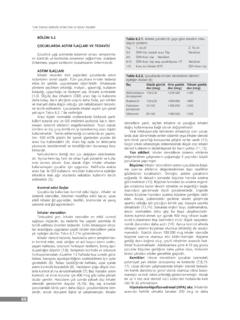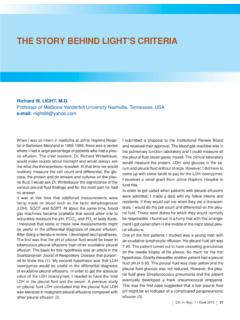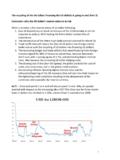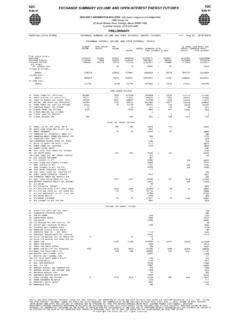Transcription of LYMPHATIC DRAINAGE OF THE PLEURA AND ITS …
1 LYMPHATIC DRAINAGE OF THE PLEURA AND ITS. effect ON tumor metastasis AND SPREAD. Zeynep Bilgi1, Yolonda L. Colson2. 1. Department of Thoracic Surgery, Dokuz Eylul University, Izmir/Turkey 2. Department of Thoracic Surgery, Brigham and Women's Hospital, Massachusetts/USA. e-mail: 1- LYMPHATIC DRAINAGE of PLEURA ; Overview of Basic can pass freely between the mesothelial cells and across Anatomy, Recent Studies the basal lamina, whereas particles of 1000 nm, are engul- fed but not transported. Lastly, removal of large particles or The PLEURA is the serous membrane that covers the lung cells from the pleural cavity depends on transport via the parenchyma, mediastinum, diaphragm, and rib cage.
2 The pleural lymphatics, which cycle pleural uid at a rate of PLEURA is divided into the visceral PLEURA , which covers the mL/kg/h (2). lung parenchyma and inter-lobar ssures, and the parietal The lymphatics within the parietal PLEURA run along the in- PLEURA that lines the inside of each hemithorax along the tercostal spaces and are virtually absent over the ribs. The- chest wall. These PLEURA fuse at the hilum where they form se LYMPHATIC vessels drain ventrally toward nodes along the pulmonary ligament (1). the internal thoracic artery and dorsally toward the inter- Visceral and parietal PLEURA are both derived from intra- nal intercostal lymph nodes near the heads of the ribs.
3 In embryonic coelom which is already covered by mesothe- contrast, the visceral PLEURA is very rich in LYMPHATIC ves- lial cells by the 7th gestational week. The coelom is divi- sels, with an intercommunicating network arranged over ded into the pleural and peritoneal cavities by the septum the lung surface and penetrating into the lung parenchyma transversum which arises from the ventral, left and right to join the bronchial lymph vessels with DRAINAGE to the va- pleuroperitoneal folds and from the posterior walls. This rious hilar nodes. The larger LYMPHATIC vessels in the vis- process ultimately separates the two pleural cavities from ceral PLEURA have one-way valves which also direct ow to- the pericardial cavity (1).
4 Ward the hilum of the lung (3). Normal PLEURA exhibits 5 layers via light microscopy; 1. a Understanding LYMPHATIC DRAINAGE of the lung and PLEURA single layer of mesothelial cells; 2. a thin submesothelial is important in the proper assessment and oncologic ma- connective tissue layer, including a basal lamina; 3. a thin nagement of patients with intrathoracic malignancies and super cial elastic layer; 4. a loose connective tissue layer; there are a few studies investigating the dynamics of pleu- and 5. a deep broelastic layer. It is the loose connective ral LYMPHATIC DRAINAGE in vivo. For example, Miura T et al, tissue layer that serves as the plane of dissection for ext- designed an experimental model utilizing the injection of rapleural pneumonectomies (1).
5 Carbon particles into the pleural cavity of Japanese mon- Pleural uid is present between the visceral and parietal keys. The entrance of carbon particles were identi ed in pleural layers and is responsible for lubrication. Mesothe- the subpleural LYMPHATIC lacunae using stereoscopy and lial cells line the pleural cavity and are characterized by scanning electron microscopy (SEM) studies. These studi- abundant microvilli and pinocytotic vesicles, with cells at es de ned two populations of mesothelial cells, one rich in the cranial aspect having less microvilli than those in the microvilli and the other with stomata.
6 The stomata-rich me- caudal portion. Water, and small molecules less than 4 nm, sothelial cells, present on the parietal PLEURA , were found to 8 TTD Plevra B lteni LYMPHATIC DRAINAGE of the PLEURA and tumor metastasis be rich in carbon particles suggesting that larger particles ring overall therapy. The study by Rahman et al focused on and cells from the pleural space can migrate out of the ple- this relationship investigating patterns of LYMPHATIC spre- ural space and into the lymphatics via these mesothelial ad in patients with malignant pleural mesothelioma. Posi- cells. Such a transport system may provide a mechanism tive mediastinal lymph nodes were commonly noted des- for migration of malignant cells to distant organs in patients pite the absence of disease in hilar nodes in patients with with positive pleural lavage cytology (4).
7 Broaddus et al. pleural invasion, whereas positive hilar lymph nodes were investigated pleural transport by iatrogenically creating a more associated with the invasion of lung parenchyma (7). pleural effusion by injecting an autologous protein solution They also noted unusual sites of spread such as the inter- at 10 mL/kg, with a protein level of g/dL, into the pleural nal mammary nodes and paraesophageal nodes as pre- space of sheep. The arti cial effusion was almost comple- dicted by the above study by Okiemy. tely removed by the lymphatics in a linear manner at a rate Pleural invasion by a parenchymal lung cancer is a bad of mL/kg/hour.
8 The calculated capacity for LYMPHATIC prognostic factor and is associated with higher inciden- clearance in this study is ~28 times greater than the normal ce of pN2 disease in patients. Manac'h et al studied more rate of pleural uid formation (2). The rate of pleural uid than 1,200 patients with visceral pleural invasion (VPI) and DRAINAGE via such LYMPHATIC pathways can be further faci- related this to prognosis. The presence of VPI was associ- litated by increased NO levels, which can occur in the set- ated with tumor size >3 cm, adenocarcinoma histology, po- ting of malignancy (5). sitive N2 disease, and a worse overall prognosis.
9 The im- Pleural DRAINAGE in humans is less well characterized. The pact of VPI was an independent contributor to bad prog- LYMPHATIC relationship of mediastinal lymph nodes and di- nosis and its impact was found to be additive to the effect aphragmatic PLEURA was studied by Okiemy G et al. Subp- of nodal status (8). Similarly, Mizuno et al reported that in leural lymphatics of 30 adult cadavers and 12 fetuses were the documented absence of pleural invasion, prognosis is injected with a modi ed Gerota's medium, with dissection similar between IA and IB disease and that LYMPHATIC and of the subsequently visualized LYMPHATIC vessels and no- vessel invasion have less impact on prognosis than VPI, des.
10 The mediastinal LYMPHATIC channels were demonstra- suggesting that pleural LYMPHATIC DRAINAGE is a more ef ci- ted to arise from the mediolateral portion of diaphragma- ent pathway for metastasis (9). tic PLEURA in 29 of the 32 cadavers. On the right, lymphatics The prognostic signi cance of visceral PLEURA involvement were observed to ascend within the inferior pulmonary li- and the subsequent increase in positive nodal status has gament and IVC and then continue further up to the upper prompted discussion of changes in the lung cancer sta- mediastinal nodes. On the left lymph vessels were ascen- ging system.
